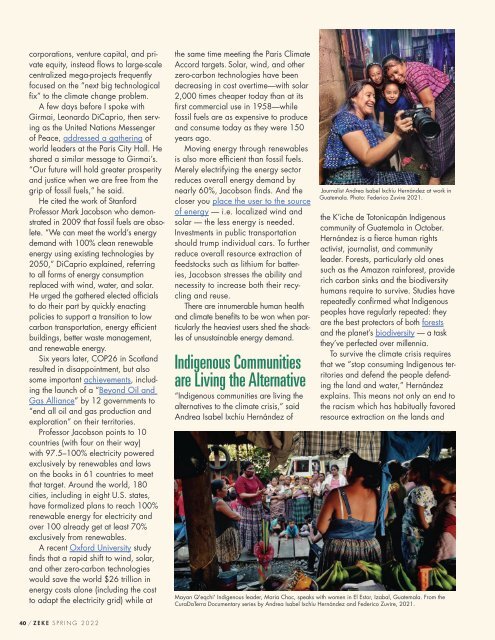ZEKE Magazine: Spring 2022
Sustainable Solutions to the Climate Crisis Indigenous Fire by Kiliii Yuyan The Indigenous Peoples' Burn Network is training others in an ancient technique of ecological restoration, which is to safely light low-intensity fires in wet seasons that remove the small fuels on the forest floor. Nemo's Garden by Giacomo d'Orlando Nemo’s Garden—the world’s first underwater greenhouses of terrestrial plants—represents an alternative farming system dedicated to those areas where environmental conditions make the growth of plants almost impossible. Permagarden Refugees by Sarah Fretwell The Palabek refugee settlement in Northern Uganda, with the staff of African Women Rising’s (AWR) Permagarden Program, works with refugees to utilize the existing resources—seeds, rainfall, limited land, and “waste”—and together build an agriculture system designed to help the environment regenerate and get stronger as it matures. Sustainable Solutions to the Climate Crisis by Antonia Juhasz Interview with Kiliii Yuyan by Caterina Clerici Dispatches from Ukraine by Maranie Staab Book Reviews Edited by Michelle Bogre
Sustainable Solutions to the Climate Crisis
Indigenous Fire by Kiliii Yuyan
The Indigenous Peoples' Burn Network is training others in an ancient technique of ecological restoration, which is to safely light low-intensity fires in wet seasons that remove the small fuels on the forest floor.
Nemo's Garden by Giacomo d'Orlando
Nemo’s Garden—the world’s first underwater greenhouses of terrestrial plants—represents an alternative farming system dedicated to those areas where environmental conditions make the growth of plants almost impossible.
Permagarden Refugees
by Sarah Fretwell
The Palabek refugee settlement in Northern Uganda, with the staff of African Women Rising’s (AWR) Permagarden Program, works with refugees to utilize the existing resources—seeds, rainfall, limited land, and “waste”—and together build an agriculture system designed to help the environment regenerate and get stronger as it matures.
Sustainable Solutions to the Climate Crisis
by Antonia Juhasz
Interview with Kiliii Yuyan by Caterina Clerici
Dispatches from Ukraine by Maranie Staab
Book Reviews Edited by Michelle Bogre
You also want an ePaper? Increase the reach of your titles
YUMPU automatically turns print PDFs into web optimized ePapers that Google loves.
corporations, venture capital, and private<br />
equity, instead flows to large-scale<br />
centralized mega-projects frequently<br />
focused on the “next big technological<br />
fix” to the climate change problem.<br />
A few days before I spoke with<br />
Girmai, Leonardo DiCaprio, then serving<br />
as the United Nations Messenger<br />
of Peace, addressed a gathering of<br />
world leaders at the Paris City Hall. He<br />
shared a similar message to Girmai’s.<br />
“Our future will hold greater prosperity<br />
and justice when we are free from the<br />
grip of fossil fuels,” he said.<br />
He cited the work of Stanford<br />
Professor Mark Jacobson who demonstrated<br />
in 2009 that fossil fuels are obsolete.<br />
“We can meet the world’s energy<br />
demand with 100% clean renewable<br />
energy using existing technologies by<br />
2050,” DiCaprio explained, referring<br />
to all forms of energy consumption<br />
replaced with wind, water, and solar.<br />
He urged the gathered elected officials<br />
to do their part by quickly enacting<br />
policies to support a transition to low<br />
carbon transportation, energy efficient<br />
buildings, better waste management,<br />
and renewable energy.<br />
Six years later, COP26 in Scotland<br />
resulted in disappointment, but also<br />
some important achievements, including<br />
the launch of a “Beyond Oil and<br />
Gas Alliance” by 12 governments to<br />
“end all oil and gas production and<br />
exploration” on their territories.<br />
Professor Jacobson points to 10<br />
countries (with four on their way)<br />
with 97.5–100% electricity powered<br />
exclusively by renewables and laws<br />
on the books in 61 countries to meet<br />
that target. Around the world, 180<br />
cities, including in eight U.S. states,<br />
have formalized plans to reach 100%<br />
renewable energy for electricity and<br />
over 100 already get at least 70%<br />
exclusively from renewables.<br />
A recent Oxford University study<br />
finds that a rapid shift to wind, solar,<br />
and other zero-carbon technologies<br />
would save the world $26 trillion in<br />
energy costs alone (including the cost<br />
to adapt the electricity grid) while at<br />
the same time meeting the Paris Climate<br />
Accord targets. Solar, wind, and other<br />
zero-carbon technologies have been<br />
decreasing in cost overtime—with solar<br />
2,000 times cheaper today than at its<br />
first commercial use in 1958—while<br />
fossil fuels are as expensive to produce<br />
and consume today as they were 150<br />
years ago.<br />
Moving energy through renewables<br />
is also more efficient than fossil fuels.<br />
Merely electrifying the energy sector<br />
reduces overall energy demand by<br />
nearly 60%, Jacobson finds. And the<br />
closer you place the user to the source<br />
of energy — i.e. localized wind and<br />
solar — the less energy is needed.<br />
Investments in public transportation<br />
should trump individual cars. To further<br />
reduce overall resource extraction of<br />
feedstocks such as lithium for batteries,<br />
Jacobson stresses the ability and<br />
necessity to increase both their recycling<br />
and reuse.<br />
There are innumerable human health<br />
and climate benefits to be won when particularly<br />
the heaviest users shed the shackles<br />
of unsustainable energy demand.<br />
Indigenous Communities<br />
are Living the Alternative<br />
“Indigenous communities are living the<br />
alternatives to the climate crisis,” said<br />
Andrea Isabel Ixchíu Hernández of<br />
Journalist Andrea Isabel Ixchíu Hernández at work in<br />
Guatemala. Photo: Federico Zuvire 2021.<br />
the K’iche de Totonicapán Indigenous<br />
community of Guatemala in October.<br />
Hernández is a fierce human rights<br />
activist, journalist, and community<br />
leader. Forests, particularly old ones<br />
such as the Amazon rainforest, provide<br />
rich carbon sinks and the biodiversity<br />
humans require to survive. Studies have<br />
repeatedly confirmed what Indigenous<br />
peoples have regularly repeated: they<br />
are the best protectors of both forests<br />
and the planet’s biodiversity — a task<br />
they’ve perfected over millennia.<br />
To survive the climate crisis requires<br />
that we “stop consuming Indigenous territories<br />
and defend the people defending<br />
the land and water,” Hernández<br />
explains. This means not only an end to<br />
the racism which has habitually favored<br />
resource extraction on the lands and<br />
Mayan Q'eqchi' Indigenous leader, Maria Choc, speaks with women in El Estor, Izabal, Guatemala. From the<br />
CuraDaTerra Documentary series by Andrea Isabel Ixchíu Hernández and Federico Zuvire, 2021.<br />
40 / <strong>ZEKE</strong> SPRING <strong>2022</strong>
















